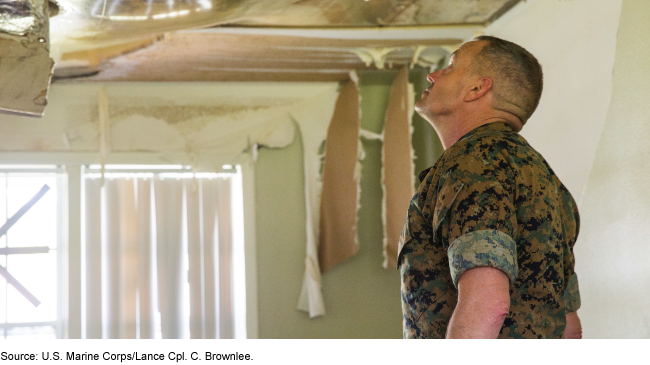Installation Management: DOD Needs Better Data, Stronger Oversight, and Increased Transparency to Address Significant Infrastructure and Environmental Challenges
Fast Facts
The Department of Defense manages hundreds of military installations around the world, with facilities and infrastructure to support its mission and the people who live and work there.
This testimony includes information from our prior reports and ongoing work on how DOD can better manage its installations to address challenges, such as:
- repair and environmental cleanup costs estimated at hundreds of billions of dollars
- potential health and safety hazards in its housing
- risks from climate change and extreme weather
In particular, DOD needs better data, stronger oversight, and increased transparency to address these challenges.
Hurricane Florence damaged this building at Marine Corps Base Camp Lejeune in North Carolina in 2018.

Highlights
What GAO Found
The Department of Defense (DOD) faces significant installation management challenges, affecting the department's ability to perform its missions and support its service members. For example, DOD has at least $137 billion in deferred facility maintenance costs and faces at least $91 billion in future environmental liability costs.
DOD has taken steps to address these challenges, but GAO's work identifies additional opportunities to improve data, strengthen oversight, and increase transparency.
- DOD needs better data to manage risk and make informed decisions in managing its installations. DOD relies on many different types of data to manage its installations, such as facility condition data, but GAO has identified weaknesses in these data. For example, GAO found that DOD is adopting a new system intended to better estimate facility maintenance requirements and standardize facility condition data across the department. However, implementation of the system has been delayed for years, does not have dedicated funding, and has been carried out inconsistently by the military services. To address these issues, GAO recommended that DOD set milestones for system implementation, develop funding plans, and ensure that facility condition data are comparable across the department.
- DOD can strengthen its oversight of installation management activities. DOD has oversight responsibilities related to installation management, such as ensuring that privatized military family housing meets health and safety standards. DOD could further strengthen its fulfillment of these responsibilities. For example, GAO found that DOD has not developed clear or consistent inspection standards for privatized housing, and the military departments have not provided adequate inspector training. These weaknesses have contributed to inconsistencies in how inspectors rate homes, leading to disagreements between military housing offices and private housing companies over repair needs, confusion among residents, and the potential for unintended impacts on the financial health of some projects. GAO recommended that DOD establish consistent inspection standards and provide better training for inspectors.
- DOD should report more transparent information within the department and to Congress. DOD's internal and external reporting on installation management enables decision-making, such as determining resource needs. However, GAO has identified opportunities to improve the transparency of this reporting. For example, certain DOD reports to Congress on Base Realignment and Closure costs have not included complete information on when environmental cleanup will finish at all sites or the associated costs of sites that need long-term environmental management. Without these data, Congress has limited clarity on the full costs associated with Base Realignment and Closure sites. GAO recommended that DOD include this information in future reports.
Why GAO Did This Study
DOD operates hundreds of military installations around the world, each with facilities to support DOD's missions and the personnel who work and live on them. DOD faces numerous challenges in managing these installations. Its facilities are aging; service members and their families have reported health and safety hazards in their privatized housing; environmental cleanup costs are substantial and are expected to increase; and installations face heightened financial risks from climate change and extreme weather events.
This testimony summarizes GAO's prior related work and provides preliminary observations on (1) DOD's installation management challenges that pose considerable costs or risks and (2) opportunities for DOD to address these challenges.
To perform the issued and ongoing work this testimony is based on, GAO reviewed DOD documentation, analyzed DOD data, interviewed officials, conducted discussion groups with service members, and assessed DOD's efforts against relevant criteria.
Recommendations
In prior work on which this testimony is based, GAO made recommendations for DOD to improve data, strengthen oversight, and increase transparency to better manage its installations. DOD generally concurred with these recommendations and is working to implement them.
